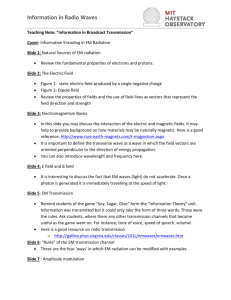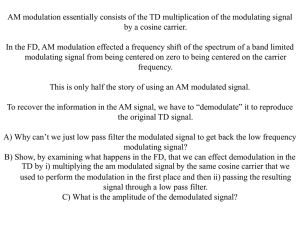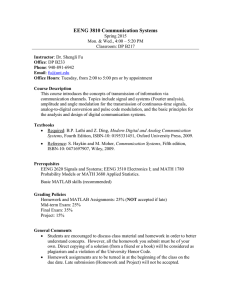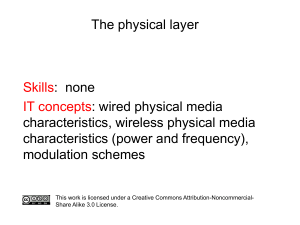Control of Appliances with Ask I.Niharika ,M.Anil Kumar
advertisement
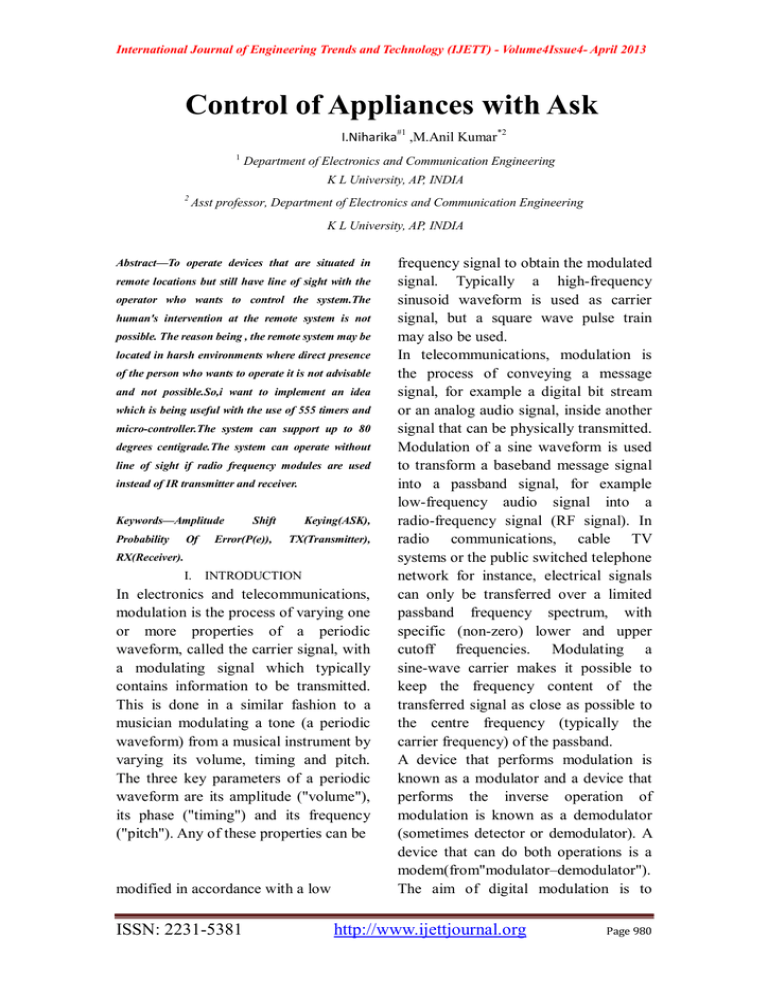
International Journal of Engineering Trends and Technology (IJETT) - Volume4Issue4- April 2013
Control of Appliances with Ask
I.Niharika#1 ,M.Anil Kumar*2
1
Department of Electronics and Communication Engineering
K L University, AP, INDIA
2
Asst professor, Department of Electronics and Communication Engineering
K L University, AP, INDIA
Abstract—To operate devices that are situated in
remote locations but still have line of sight with the
operator who wants to control the system.The
human's intervention at the remote system is not
possible. The reason being , the remote system may be
located in harsh environments where direct presence
of the person who wants to operate it is not advisable
and not possible.So,i want to implement an idea
which is being useful with the use of 555 timers and
micro-controller.The system can support up to 80
degrees centigrade.The system can operate without
line of sight if radio frequency modules are used
instead of IR transmitter and receiver.
Keywords—Amplitude
Probability
Of
Shift
Error(P(e)),
Keying(ASK),
TX(Transmitter),
RX(Receiver).
I.
INTRODUCTION
In electronics and telecommunications,
modulation is the process of varying one
or more properties of a periodic
waveform, called the carrier signal, with
a modulating signal which typically
contains information to be transmitted.
This is done in a similar fashion to a
musician modulating a tone (a periodic
waveform) from a musical instrument by
varying its volume, timing and pitch.
The three key parameters of a periodic
waveform are its amplitude ("volume"),
its phase ("timing") and its frequency
("pitch"). Any of these properties can be
modified in accordance with a low
ISSN: 2231-5381
frequency signal to obtain the modulated
signal. Typically a high-frequency
sinusoid waveform is used as carrier
signal, but a square wave pulse train
may also be used.
In telecommunications, modulation is
the process of conveying a message
signal, for example a digital bit stream
or an analog audio signal, inside another
signal that can be physically transmitted.
Modulation of a sine waveform is used
to transform a baseband message signal
into a passband signal, for example
low-frequency audio signal into a
radio-frequency signal (RF signal). In
radio communications, cable TV
systems or the public switched telephone
network for instance, electrical signals
can only be transferred over a limited
passband frequency spectrum, with
specific (non-zero) lower and upper
cutoff frequencies. Modulating a
sine-wave carrier makes it possible to
keep the frequency content of the
transferred signal as close as possible to
the centre frequency (typically the
carrier frequency) of the passband.
A device that performs modulation is
known as a modulator and a device that
performs the inverse operation of
modulation is known as a demodulator
(sometimes detector or demodulator). A
device that can do both operations is a
modem(from"modulator–demodulator").
The aim of digital modulation is to
http://www.ijettjournal.org
Page 980
International Journal of Engineering Trends and Technology (IJETT) - Volume4Issue4- April 2013
transfer a digital bit stream over an
analog band pass channel, for example
over the public switched telephone
network (where a bandpass filter limits
the frequency range to between 300 and
3400 Hz), or over a limited radio
frequency band.
The aim of analog modulation is to
transfer an analog baseband (or lowpass)
signal, for example an audio signal or
TV signal, over an analog bandpass
channel at a different frequency, for
example over a limited radio frequency
band or a cable TV network channel.
The aim of digital baseband modulation
methods, also known as line coding, is
to transfer a digital bit stream over a
baseband
channel,
typically
a
non-filtered copper wire such as a serial
bus or a wired local area network.
II.
DEMODULATION
Demodulation is the act of extracting
the original information-bearing signal
from a modulated carrier wave. A
demodulator is an electronic circuit (or
computer program in a software-defined
radio) that is used to recover the
information content from the modulated
carrier wave.
These terms are traditionally used in
connection with radio receivers, but
many other systems use many kinds of
demodulators. Another common one is
in a modem, which is a contraction of
the terms modulator/demodulator.
Since the early days of radio when all
transmissions were in Morse Code, a
demodulator has also been called a
detector. Early demodulators had only to
detect the presence (or absence) of a
radio wave using a device such as a
coherer, without necessarily making it
audible. This alternate term has survived
ISSN: 2231-5381
despite the greater sophistication of
modern circuits.
There are several ways of demodulation
depending on how parameters of the
base-band signal are transmitted in the
carrier signal, such as amplitude,
frequency or phase. For example, for a
signal modulated with a linear
modulation, like AM (Amplitude
Modulation), we can use a synchronous
detector. On the other hand, for a signal
modulated with an angular modulation,
we must use an FM (Frequency
Modulation) demodulator or a PM
(Phase
Modulation)
demodulator.
Different kinds of circuits perform these
functions.
III. TECHNIQUES
Many techniques such as carrier
recovery, clock recovery, bit slip, frame
synchronization, rake receiver, pulse
compression, Received Signal Strength
Indication, error detection and correction,
etc.,are only performed by demodulators,
although any specific demodulator may
perform only some or none of these
techniques.
An AM signal encodes the information
onto the carrier wave by varying its
amplitude in direct sympathy with the
analogue signal to be sent. There are two
methods used to demodulate AM
signals.
The envelope detector is a very simple
method of demodulation. It consists of a
rectifier (anything that will pass current
in one direction only), and a low-pass
filter. The rectifier may be in the form of
a single diode, or may be more complex.
Many natural substances exhibit this
rectification behaviour, which is why it
was the earliest modulation and
demodulation technique used in radio.
http://www.ijettjournal.org
Page 981
International Journal of Engineering Trends and Technology (IJETT) - Volume4Issue4- April 2013
The filter is usually a RC low-pass type,
but the filter function can sometimes be
achieved by relying on the limited
frequency response of the circuitry
following the rectifier. The crystal set
exploits the simplicity of AM
modulation to produce a receiver with
very few parts, using the crystal as the
rectifier, and the limited frequency
response of the headphones as the filter.
The product detector multiplies the
incoming signal by the signal of a local
oscillator with the same frequency and
phase as the carrier of the incoming
signal. After filtering, the original audio
signal will result. This method will
decode both AM and SSB, although if
the phase cannot be determined a more
complex setup is required.
An AM signal can be rectified without
requiring a coherent demodulator. For
example, the signal can be passed
through an envelope detector (a diode
rectifier and a low-pass filter). The
output will follow the same curve as the
input baseband signal. There are forms
of AM in which the carrier is reduced or
suppressed entirely, which require
coherent demodulation. For further
reading, see sideband.
Frequency modulation or FM is more
complex. It has numerous advantages
over AM, such as better fidelity and
noise immunity. However, it is much
more complex to both modulate and
demodulate a carrier wave with FM, and
AM predates it by several decades.There
are several common types of FM
demodulator:The quadrature detector,
which phase shifts the signal by 90
degrees and multiplies it with the
unshifted version. One of the terms that
drops out from this operation is the
original information signal, which is
ISSN: 2231-5381
selected and amplified. The signal is fed
into a PLL and the error signal is used as
the demodulated signal.
The most common is a Foster-Seeley
discriminator. This is composed of an
electronic filter which decreases the
amplitude of some frequencies relative
to others, followed by an AM
demodulator. If the filter response
changes linearly with frequency, the
final analog output will be proportional
to the input frequency, as desired.
IV.
AMPLITUDE SHIFT KEYING(ASK)
Amplitude-shift keying (ASK) is a
form of amplitude modulation that
represents digital data as variations in
the amplitude of a carrier wave.Any
digital scheme uses a finite number of
distinct signals to represent digital data.
ASK uses a finite number of amplitudes,
each assigned a unique pattern of binary
digits. Usually, each amplitude encodes
an equal number of bits. Each pattern of
bits forms the symbol that is represented
by the particular amplitude. The
demodulator,
which
is designed
specifically for the symbol-set used by
the modulator, determines the amplitude
of the received signal and maps it back
to the symbol it represents, thus
recovering the original data. Frequency
and phase of the carrier are kept
constant.Like AM, ASK is also linear
and sensitive to atmospheric noise,
distortions, propagation conditions on
different routes in PSTN, etc. Both ASK
modulation and demodulation processes
are relatively inexpensive. The ASK
technique is also commonly used to
transmit digital data over optical fiber.
For LED transmitters, binary 1 is
represented by a short pulse of light and
binary 0 by the absence of light. Laser
http://www.ijettjournal.org
Page 982
International Journal of Engineering Trends and Technology (IJETT) - Volume4Issue4- April 2013
transmitters normally have a fixed "bias"
current that causes the device to emit a
low light level. This low level represents
binary 0, while a higher-amplitude light
wave represents binary 1.
The simplest and most common form of
ASK operates as a switch, using the
presence of a carrier wave to indicate a
binary one and its absence to indicate a
binary zero. This type of modulation is
called on-off keying, and is used at radio
frequencies to transmit Morse code
(referred to as continuous wave
operation),More sophisticated encoding
schemes have been developed which
represent data in groups using additional
amplitude levels. For instance, a
four-level encoding scheme can
represent two bits with each shift in
amplitude; an eight-level scheme can
represent three bits; and so on.
These forms of amplitude-shift keying
require a high signal-to-noise ratio for
their recovery, as by their nature much
of the signal is transmitted at reduced
power.
transmission
hc(f) is the impulse response of the
channel
n(t) is the noise introduced by the
channel
hr(f) is the filter at the receiver
L is the number of levels that are
used for transmission
Ts is the time between the generation
of two symbols.
Different symbols are represented with
different voltages. If the maximum
allowed value for the voltage is A, then
all the possible values are in the range
[−A, A] and they are given by:
the difference between one voltage and
the other is:
Considering the picture, the symbols v[n]
are generated randomly by the source S,
then the impulse generator creates
impulses with an area of v[n]. These
impulses are sent to the filter ht to be
sent through the channel. In other words,
for each symbol a different carrier wave
is sent with the relative amplitude.
Out of the transmitter, the signal s(t) can
be expressed in the form:
Fig1:Amplitude Shift Keying
ASK Example:
ASK system can be divided into three
blocks. The first one represents the
transmitter, the second one is a linear
model of the effects of the channel, the
third one shows the structure of the
receiver. The following notation is used:
ht(f) is the carrier signal for the
ISSN: 2231-5381
In the receiver, after the filtering through
hr (t) the signal is:
where we use the notation:
http://www.ijettjournal.org
Page 983
International Journal of Engineering Trends and Technology (IJETT) - Volume4Issue4- April 2013
given by:
where * indicates the convolution
between two signals. After the A/D
conversion the signal z[k] can be
expressed in the form:
In this relationship, the second term
represents the symbol to be extracted.
The others are unwanted: the first one is
the effect of noise, the second one is due
to the inter-symbol interference.
If the filters are chosen so that g(t) will
satisfy the Nyquist ISI criterion, then
there will be no inter-symbol
interference and the value of the sum
will be zero, so:
where, for example, P_{e|H_0} is the
conditional probability of making an
error given that a symbol v0 has been
sent and P_{H_0} is the probability of
sending a symbol v0.
If the probability of sending any symbol
is the same, then:
If we represent all the probability
density functions on the same plot
against the possible value of the voltage
to be transmitted, we get a picture like
this (the particular case of L = 4 is
shown):
the transmission will be affected only by
noise.
Fig2:Probability Curve
V.
Probability of error
The probability density function of
having an error of a given size can be
modeled by a Gaussian function; the
mean value will be the relative sent
value, and its variance will be given by:
Where
The probability of making an error after
a single symbol has been sent is the area
of the Gaussian function falling under
the functions for the other symbols. It is
shown in cyan for just one of them. If
we call P+ the area under one side of the
Gaussian, the sum of all the areas will be:
2 L P^+ - 2 P^+. The total probability of
making an error can be expressed in the
form:
is the spectral density
of the noise within the band and Hr (f) is
the continuous Fourier transform of the
impulse response of the filter hr (f).
The probability of making an error is
ISSN: 2231-5381
We have now to calculate the value of
P+. In order to do that, we can move the
origin of the reference wherever we
http://www.ijettjournal.org
Page 984
International Journal of Engineering Trends and Technology (IJETT) - Volume4Issue4- April 2013
want: the area below the function will
not change. We are in a situation like the
one shown in the following picture:
Fig3:Distribution Curve
It does not matter which Gaussian
function we are considering, the area we
want to calculate will be the same. The
value we are looking for will be given
by the following integral:
where erfc() is the complementary error
function. Putting all these results
together, the probability to make an
error is:
from this formula we can easily
understand that the probability to make
an error decreases if the maximum
amplitude of the transmitted signal or
the amplification of the system becomes
greater; on the other hand, it increases if
the number of levels or the power of
noise becomes greater.This relationship
is valid when there is no inter-symbol
interference, i.e. g(t) is a Nyquist
function.
In this idea i am using two 555 Astable
multivibrators,TSOP 1738 for receiving
and demodulating and micro-controller
ATMEGA8 for verifying weather it is
transmitting 1kHz or 2kHz and IR led
for transmitting IR radiation.
Here
in
one
Astable
ISSN: 2231-5381
multivibrator i am generating 1kHz and
2kHz frequencies and in the other
Astable multivibrator i will generate
38kHz frequency because as i am using
1738 TSOP, it only receives 38kHz
frequency.The message signal 1kHz and
2kHz
modulate
the
38kHz
frequency.This modulated wave is given
to the IR led.This led transmits IR
signals and this signal is received by
TSOP1738 .When they are properly
aligned and TSOP will demodulate the
signal and it is given to the
micro-controller ATMEGA 8 to the
counter pin.This counter pin will count
the number of pulses received for
100msec.If the count is 100 we received
1kHz signal,if the count is 200 we
receive 2kHz signal.If
1KHz is
received then load1 will be ON and if
we receive 2kHz is received then load2
will be ON.
VI. Transmitter
Fig4:Transmitter using 555 Timers
VII.
Receiver
http://www.ijettjournal.org
Page 985
International Journal of Engineering Trends and Technology (IJETT) - Volume4Issue4- April 2013
_delay_ms(1000);
PORTB&=(0<<1);
i=0;
}
else
{;
}
}
return 0;
}
IX.
Fig5: TSOP1738 as Receiver
VIII. SOURCE CODE
include<avr/io.h>
#include<util/delay.h>
void main()
{
DDRD&=!(1<<4);
DDRB|=(1<<0)|(1<<1);
TCCR0=0X07;
TCNT0=0X00;
int i;
while(1)
{
_delay_ms(100);
i=TCNT0;
if ((i>=90)&&(i<=110))
{
PORTB|=(1<<0);
_delay_ms(1000);
PORTB&=(0<<0);
i=0;
}
CONCLUSION
Here i have used only 2 modulating
frequencies.For extension we may use
any no.of frequencies.Maximum range
of operation of this is only 10 meters.
We can go for longer distances if the
carrier frequency is also made high.But
at present there are no high frequency
demodulation circuits available.
ACKNOWLEDGMENT
I would like to thank management and
department of ECE, KL University for
continuous help and support during this
work. I express thanks to Anil Kumar sir
for his encouragement and support
during this work.
REFERENCES
[1] Digital communications by "Simon Haykin".
[2] Communication systems by "Bakshi".
[3] Digital communications by "John G.Proakis".
[4] Communication systems by "J.S.Chitode".
else if ((i>=190)&&(i<=210))
{
PORTB|=(1<<1);
ISSN: 2231-5381
http://www.ijettjournal.org
Page 986
